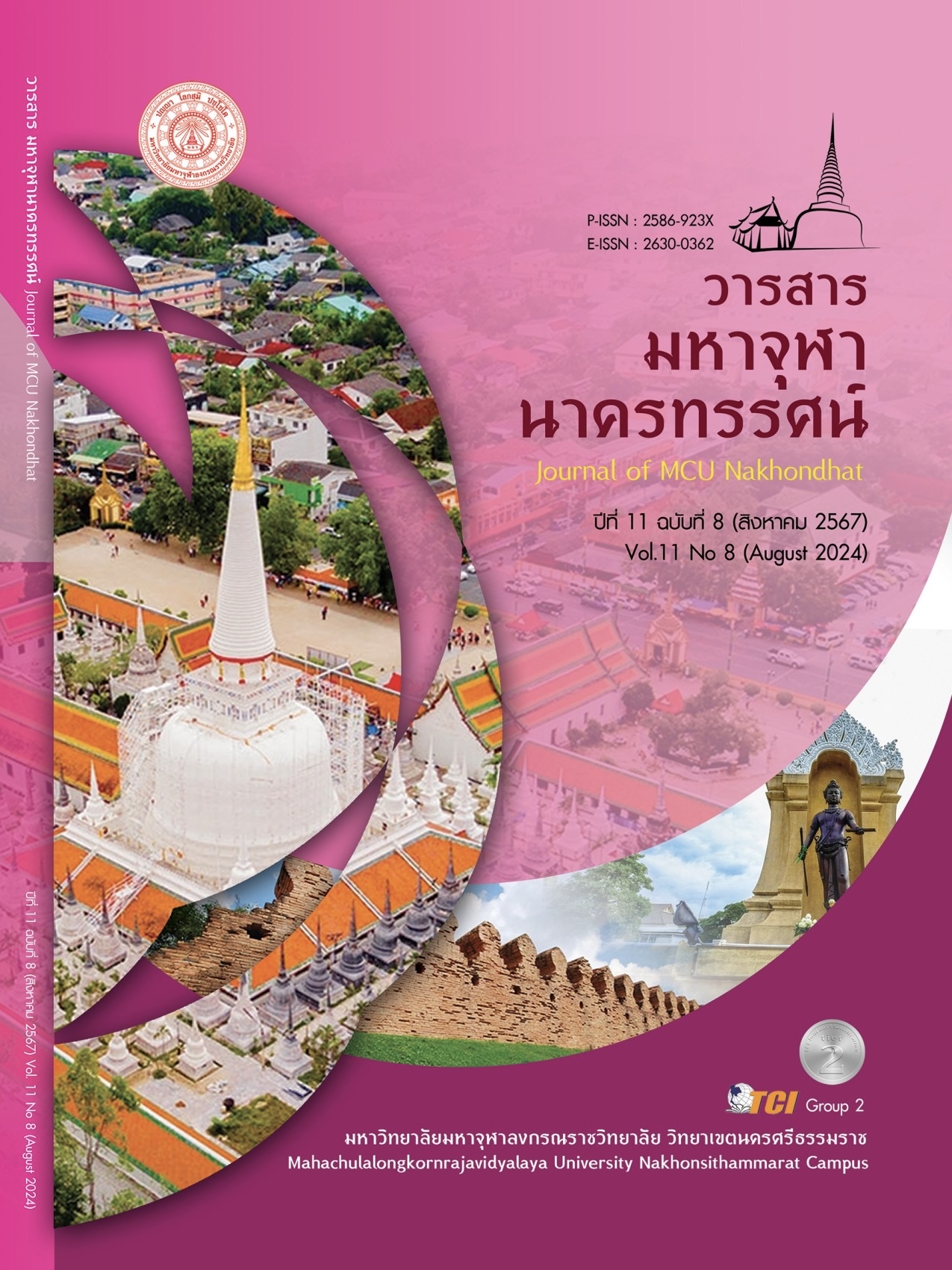OLD MON INSCRIPTIONS FOR THE CREATION OF MUSIC COMPOSITION THE SACRED SONG: RETRACING IN LAWOE KINGDOM INSCRIPTIONS
Main Article Content
Abstract
This research is qualitative research to study and analyse the old Mon language inscriptions that appeared in Lopburi and their sequels. The research found that Lawoe or Lopburi City in the past shows evidence of human habitation since the prehistoric era. Subsequently, when they especially received an Indian culture, Lopburi had developed initially into an intercultural state associated with a Dvaravati culture in the central part of Thailand, such as Nakhon Pathom, U Thong, Khu Bua, etc., namely "Lavapura" in contemporary evidence especially in the 12th-14th Buddhist centuries. Therefore, Lopburi Province also had evidence of stone inscriptions using the Pallava script or Pallava Grantha, Pali, Sanskrit, and the old Mon script that was exemplified by the Sap-Cham-Pa inscription, the Pillar of Dharmachakra inscription, etc. This evidence indicated the presence of a Buddhist community that used the Mon language as an official language. The inscriptions were in Pali and had the same content, namely the Octagonal Pillar 1 (Sub Champa) and the Sub Champa 4 Inscription, which consists of 4 important passages from the Tripitaka are Ye Dhamma verse, a description of the Four Noble Truths, and Buddhist Exclamation, led to the creation of music composition; the sacred song: "Retracing in Lawoe Kingdom Inscription". It consisted of 4 double-rhythm melodies, namely "Pa Tom Bot Ye Tham Ma" means The First Chapter of Ye Dhamma. It was a combination of the Ye Dhamma song, Yan song 3, Buddha Uthan song 1, and Buddha Uthan song 2, all of which were songs in the Mon dialect with Na Tab Mon rhythm. This was provided by using both the middle and Phiang O Bon sound scales of Thai music with the playing of a semi-general melodic line. Use the mixture of archaeological band by Kru Montri Tramod This music creation will effectively promote tourism in Lopburi Province during essential annual festivals.
Article Details

This work is licensed under a Creative Commons Attribution-NonCommercial-NoDerivatives 4.0 International License.
References
กรมศิลปากร. (2524). จารึกโบราณรุ่นแรกพบที่ลพบุรีและใกล้เคียง. กรุงเทพมหานคร: กรมศิลปากร.
กรมศิลปากร. (2559). จารึกประเทศไทย เล่ม 2. (พิมพ์ครั้งที่ 2). กรุงเทพมหานคร: กรมศิลปากร.
เดชา สุดสวาท. (27 พฤศจิกายน 2566). งานทำบุญเมืองประจำปี วัดพระศรีรัตนมหาธาตุ ลพบุรี. (ปภาอร แก้วสว่าง, ผู้สัมภาษณ์)
นพคุณ สุดประเสริฐ. (9 พฤษภาคม 2567). รูปแบบการขับร้องหรือขับลำนำงานสร้างสรรค์ทางดุริยางคศิลป์. (ปภาอร แก้วสว่าง, ผู้สัมภาษณ์)
พงษ์ศักดิ์ นิลวร. (2553). ร่อยรอยพุทธศาสนาสมัยทวารวดีบริเวณลุ่มแม่น้ำลพบุรี-ป่าสัก ศึกษาจากหลักฐานทางโบราณคดี ประเภทศิลปกรรมและจารึก. ใน วิทยานิพนธ์ศิลปศาสตรมหาบัณฑิต สาขาวิชาโบราณคดีสมัยประวัติศาสตร์. มหาวิทยาลัยศิลปากร.
พิชิต ชัยเสรี. (2557). การประพันธ์เพลงไทย. กรุงเทพมหานคร: สำนักพิมพ์แห่งจุฬาลงกรณ์มหาวิทยาลัย.
พิมพ์พรรณ ไพบูลย์หวังเจริญ. (9 พฤษภาคม 2567). ประเภทคำประพันธ์ที่ใช้ในงานสร้างสรรค์ทางดุริยางคศิลป์. (ปภาอร แก้วสว่าง, ผู้สัมภาษณ์)
พิเศษ เจียจันทร์พงษ์. (2561). ทวารวดี เมืองที่ชุมนุมพระธาตุ. วารสารศิลปากร, 61(1), 49-55.
มนตรี ตราโมท. (2538). ดุริยสาส์นของนายมนตรี ตราโมท. กรุงเทพมหานคร: ธนาคารกสิกรไทย จำกัด (มหาชน).
มานพ วิสุทธิแพทย์. (2533). ดนตรีไทยวิเคราะห์. (พิมพ์ครั้งที่ 1). กรุงเทพมหานคร: โรงพิมพ์ชวนพิมพ์.
วรพจน์ มานะสมปอง. (15 มกราคม 2567). การประพันธ์เพลงชุดสำเนียงภาษา. (ปภาอร แก้วสว่าง, ผู้สัมภาษณ์)
ศักดิ์ชัย สายสิงห์. (2562). ศิลปะทวารวดี วัฒนธรรมทางศาสนายุคแรกเริ่มในดินแดนไทย. (พิมพ์ครั้งที่ 2). นนทบุรี: เมืองโบราณ.
ศูนย์มานุษยวิทยาสิรินธร (องค์การมหาชน). (2566). ชุดข้อมูลจารึกในพิพิธภัณฑสถานแห่งชาติสมเด็จพระนารายณ์. เรียกใช้เมื่อ 15 ธันวาคม 2566 จาก https://db.sac.or.th/inscriptions/dataset/detail/47.
สิริชัยชาญ ฟักจำรูญ. (2546). ดุริยางคศิลป์ไทย. กรุงเทพมหานคร: สำนักพิมพ์สถาบันไทยศึกษาจุฬาลงกรณ์ มหาวิทยาลัย.
อิโคโมสไทย. (2548). กฎบัตรอิโคโมส ว่าด้วยการสื่อความหมายและการนําเสนอแหล่งมรดกวัฒนธรรม. กรุงเทพมหานคร: อิโคโมสไทย.
ฮันเตอร์ เอียน วัตสัน. (2556). การศึกษารูปคำภาษามอญโบราณจากจารึกที่พบในประเทศไทย ระหว่างพุทธศตวรรษที่ 12-17. ใน วิทยานิพนธ์ศิลปศาสตรมหาบัณฑิต สาขาวิชาจารึกภาษาตะวันออก. มหาวิทยาลัยศิลปากร.


